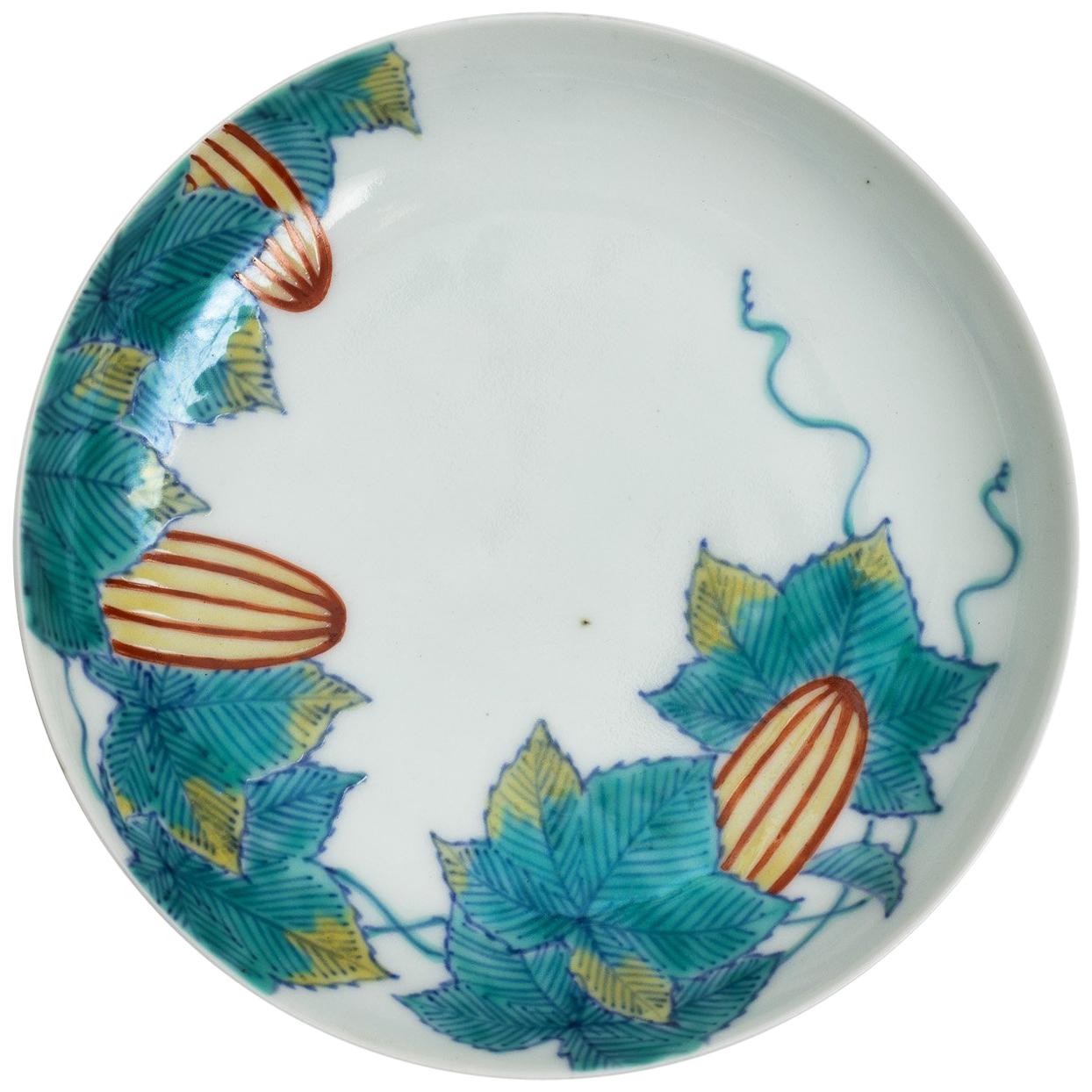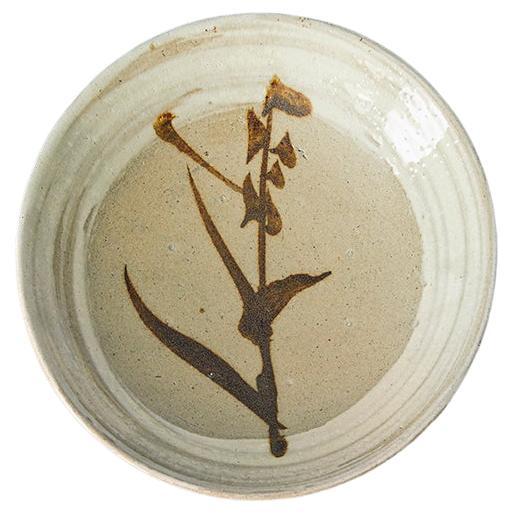Items Similar to Japanese Ko-Seto Stoneware Ewer with Carved Design
Want more images or videos?
Request additional images or videos from the seller
1 of 21
Japanese Ko-Seto Stoneware Ewer with Carved Design
About the Item
On offer is a rare Ko-seto (old seto) stoneware ewer from Kamakura period (12-14th century) Japan. The exceptionally heavily potted ewer is made of stoneware. The main body was likely hand-coiled with individually built handle, sprout and wheel-made neck and mouth assembled. It takes the basic form from the contemporary Chinese ewer of Song Dynasty. The body was decorated with large carved chrysanthemums with petals surrounding the bottom of the neck and the base. It was washed in a yellow glaze (ko-seto was one the place first used glaze), the color was known as "dead leaf brown". The glaze now showcases an even effect of small crackles. The base was quite scorched and uneven from the residues during kiln firing. There is an old thin vein of kintsugi repair around the sprout, the end of which has a historical chip is uneven to the touch.
While the Ko-seto stoneware jar (heishi) are more commonly preserved from the period, the handled ewer that derived from the Chinese form is rather obscure. An intact Sue stoneware ewer of a similar form from Heian Period (10-11th century) was excavated at Maebashi in Gumma Prefecture in 1961 (see last picture).
For a Ko-seto jar with carved design and similar glaze, see item 1991.6 in the collection of Asian Art Musuem in San Francisco. Item AFI.14.2016 in the collection of Birmingham Musuem of Art
- Dimensions:Height: 11 in (27.94 cm)Diameter: 6.5 in (16.51 cm)
- Style:Archaistic (Of the Period)
- Materials and Techniques:Stoneware,Glazed
- Place of Origin:
- Period:
- Date of Manufacture:13th-14th Century
- Condition:Repaired: Ab historical Kintsugi repair around the sprout. Wear consistent with age and use. Minor losses. Overall fine condition. Old chip at the end of the sprout as shown.
- Seller Location:Atlanta, GA
- Reference Number:1stDibs: LU945031270192
About the Seller
5.0
Platinum Seller
These expertly vetted sellers are 1stDibs' most experienced sellers and are rated highest by our customers.
Established in 2006
1stDibs seller since 2010
478 sales on 1stDibs
Typical response time: <1 hour
- ShippingRetrieving quote...Ships From: Atlanta, GA
- Return PolicyA return for this item may be initiated within 2 days of delivery.
More From This SellerView All
- Pair Antique Japanese Artia Ceramic Cabinet PlatesBy AritaLocated in Atlanta, GAA pair of Japanese decorative ceramic plates, made in Arita for export market circa 17-18th century. The cabinet-display dishes feature lotus-petal gilt rim and a lavish tricolor ene...Category
Antique 18th Century Japanese Japonisme Ceramics
MaterialsCeramic
- Rare Large Japanese Porcelain Presentation Plate Makuzu KozanBy Makuzu KozanLocated in Atlanta, GAA large presentation plate with striking pictorial design from the studio of Japanese Potter Makuzu Kozan. Also known as Miyagawa Kozan (1842–1916),...Category
Early 20th Century Japanese Meiji Ceramics
MaterialsPorcelain
- Japanese Ceramic Centerpiece Bowl Makuzu Kozan Meiji PeriodBy Makuzu KozanLocated in Atlanta, GAA beautiful ceramic vessel in the form of Bo, the so-called monk's alms bowl from the studio of Japanese Potter Makuzu Kozan, also known as Miyagawa Kozan (1842–1916), one of the most established and collected ceramist from Meiji Period. Born as Miyagawa Toranosuke, Kozan established his pottery studio in Yokohama circa 1870s and later became one of the appointed artists to the Japanese Imperial household. His work was exhibited in many international fairs that the Meiji government participated at the turn of the century and won many grand prizes. Of a relatively large size, this piece was made as a decorative center piece for display. It was brilliantly decorated with underglaze paint of a green-on-green bamboo motif, using the novel technique developed by Kozan called Fuki-e (the blow painting). As a result, the bamboos appear took on a three-dimensional quality as if appearing in a mist. Known as one of the most creative ceramists, circa 1887, Kozan started experimenting with new chemical colors from the West in the format of his porcelain glaze. New colors allowed him to create underglaze design that appeared bright, smooth and glossy. To create design that is realistic and dimensional, more common in the western paintings, he was inspired by the native Japanese ink painting technique developed around 1900 by Yokoyama Taikan...Category
Antique Early 1900s Japanese Japonisme Ceramics
MaterialsCeramic
- Japanese Mino Ware Oribe Type Chawan Tea BowlLocated in Atlanta, GAA Japanese Kutsu-gata (clog-shaped) chawan (tea bowl) circa 19th century possibly older. The stoneware bowl potted from buff clay has a slight irregular shape and an unusual depth for a tea bowl. Of Mino ware...Category
Antique 19th Century Japanese Meiji Ceramics
MaterialsCeramic
- Rare Japanese Porcelain Painted Footed Dish Makuzu KozanBy Makuzu KozanLocated in Atlanta, GAA rare footed dish in the form of an open scroll painting with literati landscape from the studio of Japanese Potter Makuzu Kozan. Also known as Miyagawa Kozan (1842–1916), Makuzu wa...Category
Antique Early 1900s Japanese Meiji Ceramics
MaterialsPorcelain
- Japanese Satsuma Ceramic Ewer Yabu MeizanBy Yabu MeizanLocated in Atlanta, GAA Satsuma ware miniature ewer from the studio of Yabu Meizan (birth name Yabu Masashichi; 1853-1934), who was one of the most celebrated and collectible Satsuma artists from the Meij...Category
Early 20th Century Japanese Japonisme Ceramics
MaterialsCeramic
You May Also Like
- Large Japanese Ko-Kutani Charger, Early 20th CenturyLocated in Melbourne, VictoriaA rare yellow ground Japanese ceramic charger 15.5 inches in diameter. Decorated on a yellow base with a bird, foliage and blossom in shades of yellow, blue, brown and green. S...Category
Early 20th Century Japanese Meiji Ceramics
MaterialsPorcelain
- Edo-Meiji 19th century Japanese mingei Seto stoneware Ishizara plateLocated in Chiba, JPISHIZARA PLATE – Old Japanese mingei Seto stoneware plate called ‘Ishizara’ (lit. ‘Stone plate’), Edo-Meiji period, 19th century, approx. D 33.5 x H 6cm (13.18 x 2.36in), once used a...Category
Antique Mid-19th Century Ceramics
MaterialsCeramic
- Edo-Meiji 19th century Japanese mingei Seto stoneware large Ishizara plateLocated in Chiba, JPISHIZARA PLATE – Old Japanese mingei Seto stoneware large plate called ‘Ishizara’ (lit. ‘Stone plate’), Edo-Meiji period, 19th century, approx. D 38 x H 6.8cm (14.96 x 2.67in), once ...Category
Antique Mid-19th Century Ceramics
MaterialsCeramic
- Late 17th Early 18th Century Nabeshima Japanese Porcelain Plate Fruit DesignLocated in Milano, ITDish with karatuuri (melon) design Late 17th-early 18th century Porcelain decorated with cobalt blu underglaze and red fruits Diameter 15.2 cm Nabeshima ware was made at Okawachi near Arita in Kyushu under the authority of the Nabeshima clan. The feudal lords of Nabeshima were so proud of their technological skill, that throughout the Edo period (1615-1867) they gave porcelain (and swords) as presents to the lords of other provinces. Most of Nabeshima porcelain...Category
Antique Late 17th Century Japanese Ceramics
MaterialsPorcelain
- Vintage Shoji Hamada Ceramic Dish in Stem/Leaf Design from Mashiko, Japan, 1970sLocated in Copenhagen K, DKShoji Hamada Japan, 1970's Dish in stem/leaf design, from Mashiko, in original wooden box. Ø 20 x D 5 cmCategory
Vintage 1970s Japanese Ceramics
MaterialsCeramic
- Antique Japanese Seto Ware Plant Stand with Calligraphy DécorLocated in Yonkers, NYAn antique Japanese Seto ware plant stand with calligraphy décor and circular top. This antique Japanese Seto ware plant stand, adorned with exquisite calligraphy décor, is a testame...Category
Antique 19th Century Japanese Ceramics
MaterialsPottery
Recently Viewed
View AllMore Ways To Browse
With Asian Design
Japan Carved
Japan Carved Furniture
Japanese Carved Furniture
Japanes Carved Furniture
Japanese Carved
Ceramics From Japan
Japanese Hand Carved
Antique Japanese Carved Furniture
Antique Stoneware
Stoneware Antique
Collection Stoneware
Old Japanese China
Decorated Stoneware
11th Century
Ewers
Japanese Stoneware
Stoneware Japan





